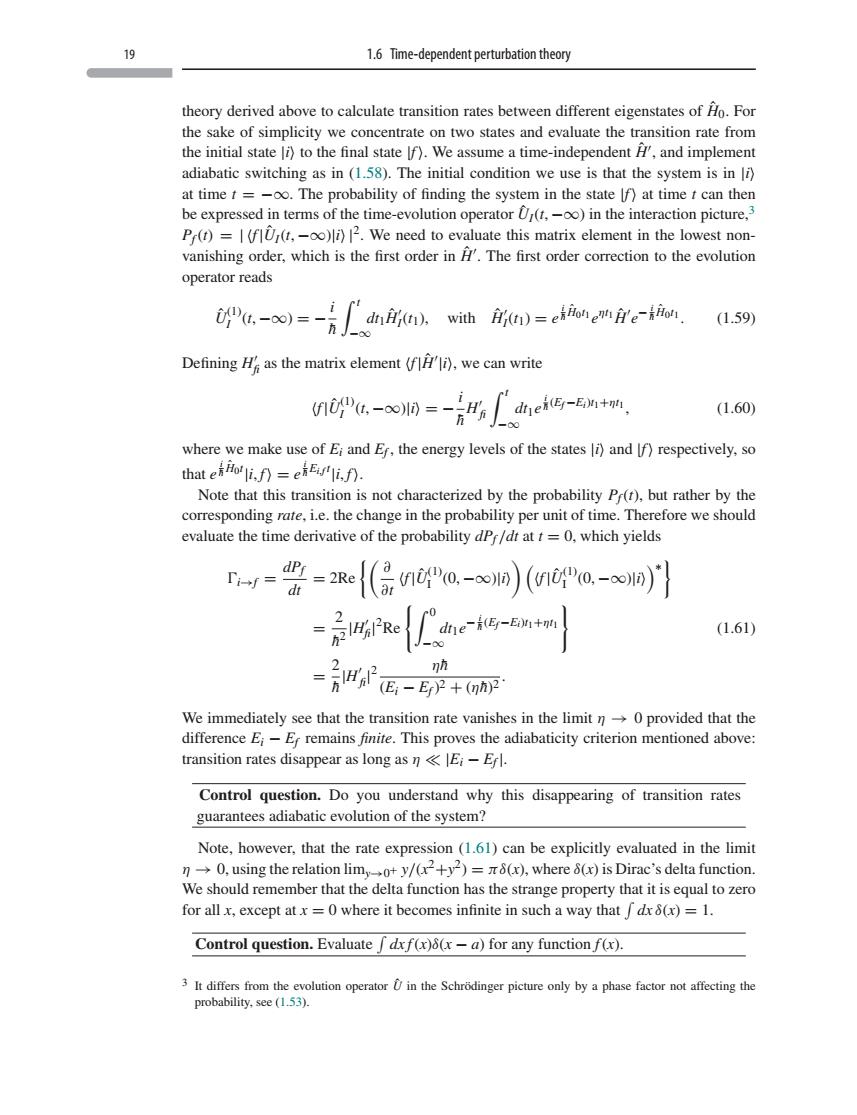正在加载图片...

1.6Time-dependent thry theory derived above to calculate transition rates between different eigenstates of Ho.Fo the sake of simplicity we concentrate on two states and evaluate the transition rate from the initial state li)to the final state If).We assume a time-independent H'.and implement adiabatic switching as in (1.58).The initial condition we use is that the system is in i) at time t =-oo.The probability of finding the system in the state f)at time t can then expressed in be erms of the tim olution erator t. )in the eraction picture. Pr()=f)2.We need to evaluate this matrix element in the lowest non- vanishing order,which is the first order in H'The first order correction to the evolution operator reads ,-o)=-方厂dh.wi所)=eamea (1.59 Defining H as the matrix element (fi),we can write ((.)=dneivy-E+an (1.60) where we make use of E and Er,the energy levels of the states i)and lf)respectively,so that eo i=ei). Note that this transition is not characterized by the probability Pr(r).but rather by the corresponding rate,i.e.the change in the probability per unit of time.Therefore we should evaluate the time derivative of the probability dP/dt att=0.which yields r-r-费=2c{(层no-m)(a0-o间) =京PRe八de-EM+n (1.61) h (+ provided that the transition rates disappear as long as n<Ei-Efl. Control question.Do you understand why this disappearing of transition rates guarantees adiabatic evolution of the system? Note,however,that the rate expression (1.61)can be explicitly evaluated in the limit elation li )where is Dirac's delta e ormember that the deeoa the srmge property that uater nctior for all x.except atx =0 where it becomes infinite in such a way that dr(x)=1. Control question.(x)(x-a)for any function f(r). 1.5 olution operatorin the Schrodinger picture oy by a phase factor not affecting the 19 1.6 Time-dependent perturbation theory theory derived above to calculate transition rates between different eigenstates of Hˆ 0. For the sake of simplicity we concentrate on two states and evaluate the transition rate from the initial state |i to the final state |f. We assume a time-independent Hˆ , and implement adiabatic switching as in (1.58). The initial condition we use is that the system is in |i at time t = −∞. The probability of finding the system in the state |f at time t can then be expressed in terms of the time-evolution operator Uˆ I(t, −∞) in the interaction picture,3 Pf(t) = |f |Uˆ I(t, −∞)|i |2. We need to evaluate this matrix element in the lowest nonvanishing order, which is the first order in Hˆ . The first order correction to the evolution operator reads Uˆ (1) I (t, −∞) = − i h¯ t −∞ dt1Hˆ I(t1), with Hˆ I(t1) = e i h¯ Hˆ 0t1 eηt1Hˆ e − i h¯ Hˆ 0t1 . (1.59) Defining H fi as the matrix element f |Hˆ |i, we can write f |Uˆ (1) I (t, −∞)|i=− i h¯ H fi t −∞ dt1e i h¯ (Ef −Ei)t1+ηt1 , (1.60) where we make use of Ei and Ef , the energy levels of the states |i and |f respectively, so that e i h¯ Hˆ 0t |i, f = e i h¯ Ei,f t |i, f. Note that this transition is not characterized by the probability Pf(t), but rather by the corresponding rate, i.e. the change in the probability per unit of time. Therefore we should evaluate the time derivative of the probability dPf /dt at t = 0, which yields i→f = dPf dt = 2Re ∂ ∂t f |Uˆ (1) I (0, −∞)|i f |Uˆ (1) I (0, −∞)|i ∗ = 2 h¯ 2 |H fi| 2Re 0 −∞ dt1e − i h¯ (Ef −Ei)t1+ηt1 = 2 h¯ |H fi| 2 ηh¯ (Ei − Ef)2 + (ηh¯)2 . (1.61) We immediately see that the transition rate vanishes in the limit η → 0 provided that the difference Ei − Ef remains finite. This proves the adiabaticity criterion mentioned above: transition rates disappear as long as η |Ei − Ef |. Control question. Do you understand why this disappearing of transition rates guarantees adiabatic evolution of the system? Note, however, that the rate expression (1.61) can be explicitly evaluated in the limit η → 0, using the relation limy→0+ y/(x2+y2) = πδ(x), where δ(x) is Dirac’s delta function. We should remember that the delta function has the strange property that it is equal to zero for all x, except at x = 0 where it becomes infinite in such a way that dx δ(x) = 1. Control question. Evaluate dx f(x)δ(x − a) for any function f(x). 3 It differs from the evolution operator Uˆ in the Schrödinger picture only by a phase factor not affecting the probability, see (1.53).����